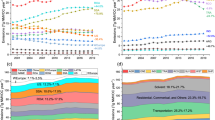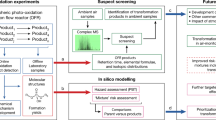Abstract
Modeling of inhalation exposure and risks resulting from exposure to mobile source air toxics can be used to evaluate impacts of reductions from control programs on overall risk, as well as changes in relative contributions of different source sectors to risk, changes in contributions of different pollutants to overall risk, and changes in geographic distributions of risk. Such analysis is useful in setting regulatory priorities, and informing the decision-making process. In this paper, we have conducted national-scale air quality, exposure, and risk modeling for the US in the years 2015, 2020, and 2030, using similar tools and methods as the 1999 National-Scale Air Toxics Assessment. Our results suggest that US Environmental Protection Agency emission control programs will substantially reduce average inhalation cancer risks and potential noncancer health risks from exposure to mobile source air toxics. However, cancer risk and noncancer hazard due to inhalation of air toxics will continue to be a public health concern.
This is a preview of subscription content, access via your institution
Access options
Subscribe to this journal
Receive 6 print issues and online access
$259.00 per year
only $43.17 per issue
Buy this article
- Purchase on Springer Link
- Instant access to full article PDF
Prices may be subject to local taxes which are calculated during checkout








Similar content being viewed by others
References
Battelle . Estimated background concentrations for the National-Scale Air Toxics Assessment. Prepared for U.S. EPA, Office of Air Quality Planning and Standards. 2003. Contract No. 68-D-02-061, Work Assignment 1-03, 2003 (available at http://www.epa.gov/ttn/atw/nata1999).
Cohen J., Cook R., Bailey C.R., and Carr E. Relationship between motor vehicle emissions of hazardous pollutants, roadway proximity, and ambient concentrations in Portland, Oregon. Environ Modeling & Software 2005: 20: 7–12.
Cook R., Glover E., Michaels H., and Brzezinski D. Modeling of mobile source air toxics using EPA's National Mobile Inventory Model. Proceedings, 2004 Emission Inventory Conference, Clearwater Beach, Fl,, 2004b: http://www.epa.gov/ttn/chief/conference/ei13/poster/cook.pdf.
Cook R., Jones B., and Cleland J. A cohort based approach for characterizing lifetime inhalation cancer risk from time-varying exposure to air toxics from ambient sources. Environmental Progress 2004a: 23 (2): 120–125.
Glen G., Lakkadi Y., Tippett J.A., and del Valle-Torres M. Development of NERL/CHAD: The National Exposure Research Laboratory Consolidated Human Activity Database. Prepared by ManTech Environmental Technology, Inc. EPA Contract No. 68-D5-0049, 1997.
Kinnee E.J., Touma J.S., Mason R., Thurman J., Beidler A., Bailey C., and Cook R. Allocation of Onroad Mobile Emissions to Road Segments for Air Toxics Modeling in Harris County, Texas. Transport Res Part D 2004: 9: 139–150.
Michaels H., Brzezinski D., and Cook R. EPA's National Mobile Inventory Model (NMIM), A Consolidated Emissions Modeling System for MOBILE6 and NONROAD, U.S. Environmental Protection Agency, Office of Transportation and Air Quality, Assessment and Standards Division, Ann Arbor, MI, March 2005; Report No. EPA-420-R-05-003.
Pratt G.C., Wu C.Y., and Bock D., et al. Comparing air dispersion model predictions with measured concentrations of VOCs in urban communities. Env Sci Technol 2004: 38: 1949–1959.
Rosenbaum A. The HAPEM5 User's Guide: Hazardous Air Pollutant Exposure Model, Version 5. Prepared by ICF, Inc. for U.S. EPA, 2005 (available at http://www.epa.gov/ttn/fera/hapem5/hapem5_guide.pdf).
South Coast Air Quality Management District. Multiple Air Toxics Exposure Study in the South Coast Air Basin – MATES-II, 2000 (available at http://www.aqmd.gov/matesiidf/matestoc.htm).
Strum M., Cook R., Thurman J., Ensley D., Pope A., Palma T., Mason R., Michaels H., and Shedd S. Projection of hazardous air pollutant emissions to future years. Sci Total Env 2006: 366: 590–601.
Touma J.S., Isakov V., Ching J., and Seigneur C. Air Quality Modeling of Hazardous Air Pollutants: Current Status and Future Directions. J Air Waste Manage Assoc 2006: 56: 547–558.
U.S. Environmental Protection Agency. Motor Vehicle-Related Air Toxics Study, Office of Mobile Sources, Ann Arbor, MI, 1993 Report No. EPA 420-R-93-005, 1993 (available at http://www.epa.gov/otaq/regs/toxics/tox_archive.htm).
U.S. Evironmental Protection Agency. Carcinogenic Effects of Benzene: An Update, National Center for Environmental Assessment, Washington, DC, 1998 EPA600-P-97-001F. (available at http://www.epa.gov/ncepihom/Catalog/EPA600P97001F.html).
U.S. Environmental Protection Agency. Analysis of the Impacts of Control Programs on Motor Vehicle Toxics Emissions and Exposure in Urban Areas and Nationwide. Prepared for U. S. EPA, Office of Transportation and Air Quality, by Sierra Research, Inc., and Radian International Corporation/Eastern Research Group, 1999 Report No. EPA 420 –R-99-029/030. (available at http://www.epa.gov/otaq/regs/toxics/tox_archive.htm).
U.S. Environmental Protection Agency. User's Guide for the Assessment System for Population Exposure Nationwide (ASPEN, Version 1.1) Model, Office of Air Quality Planning and Standards, Research Triangle Park, NC, 2000 Report No. EPA-454/R-00-017. (Available at http://www.epa.gov/scram001/userg/other/aspenug.pdf).
U.S. Environmental Protection Agency. National-Scale Air Toxics Assessment for 1996: Draft for EPA Science Advisory Board Review, 2001 Report No. EPA-453/R-01-003. (available at http://www.epa.gov/ttn/atw/sab/natareport.pdf).
U.S. Environmental Protection Agency. Health Assessment of 1,3-Butadiene, Office of Research and Development, National Center for Environmental Assessment, Washington, DC, 2002a Report No. EPA600-P-98-001F (Available at http://cfpub.epa.gov/ncea/cfm/recordisplay.cfm?deid=54499).
U.S. Environmental Protection Agency. National-Scale Air Toxics Assessment for 1996, 2002b (Available at http://www.epa.gov/ttn/atw/nata).
U.S. Environmental Protection Agency. 1999 Final National Emissions Inventory Data and Documentation, 2004a (available at http://www.epa.gov/ttn/chief/net/1999inventory.html).
U.S. Environmental Protection Agency. User's Guide for the Emissions Modeling System for Hazardous Air Pollutants (EMS-HAP, Version 3.0), Office of Air Quality Planning and Standards, Research Triangle Park, NC, 2004b Report No. EPA-454/B-00-007. (available at http://www.epa.gov/scram001/tt22.htm#aspen.
U.S. Environmental Protection Agency. Supplemental Guidance for Assessing Susceptibility from Early-Life Exposure to Carcinogens, 2005 Report No. EPA/630/R-03/003F. (available at http://cfpub.epa.gov/ncea/cfm/recordisplay.cfm?deid=116283).
U.S. Environmental Protection Agency. Draft Regulatory Impact Analysis: Control of Hazardous Air Pollutants from Mobile Sources, Office of Transportation and Air Quality, Ann Arbor, MI, 2006a Report No. EPA420-D-06-004. (available at http://www.epa.gov/otaq/toxics.htm).
U.S. Environmental Protection Agency. National-Scale Air Toxics Assessment for 1999, 2006b (available at http://www.epa.gov/ttn/atw/nata1999).
Acknowledgements
We acknowledge the contributions of Chad Bailey, David Brzezinski, Harvey Michaels, and Kathryn Sargeant, US EPA, Office of Transportation and Air Quality, and Anne Pope, Laurel Driver, Richard Mason, and Stephen Shedd of US EPA, Office of Air Quality Planning and Standards, to the work presented in this paper. We would also like thank Dr. Chon Shoaf, US EPA, Office of Research and Development, and Dr. Kenneth Mitchell, US EPA, Region 4, for comments on a draft of this paper.
Author information
Authors and Affiliations
Corresponding author
Additional information
Disclaimer
This paper has been reviewed in accordance with the US EPA peer and administrative review policies and approved for presentation and publication. Mention of trade names or commercial products does not constitute endorsement or recommendation for their use.
Rights and permissions
About this article
Cite this article
Cook, R., Strum, M., Touma, J. et al. Inhalation exposure and risk from mobile source air toxics in future years. J Expo Sci Environ Epidemiol 17, 95–105 (2007). https://doi.org/10.1038/sj.jes.7500529
Received:
Accepted:
Published:
Issue Date:
DOI: https://doi.org/10.1038/sj.jes.7500529
Keywords
This article is cited by
-
On exposure and response relationships for health effects associated with exposure to vehicular traffic
Journal of Exposure Science & Environmental Epidemiology (2008)



